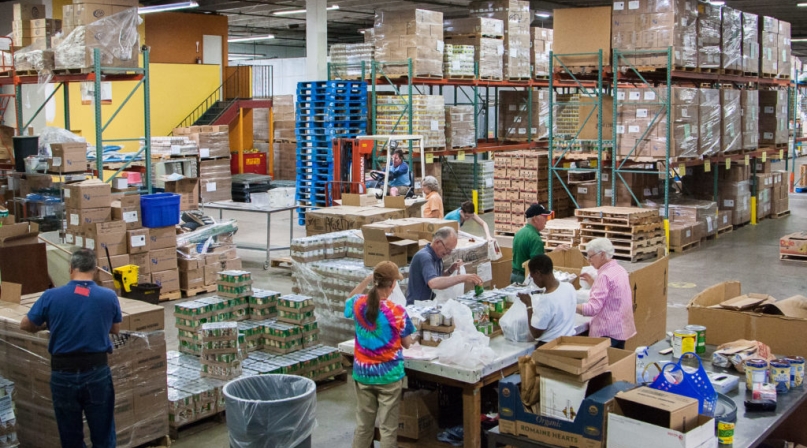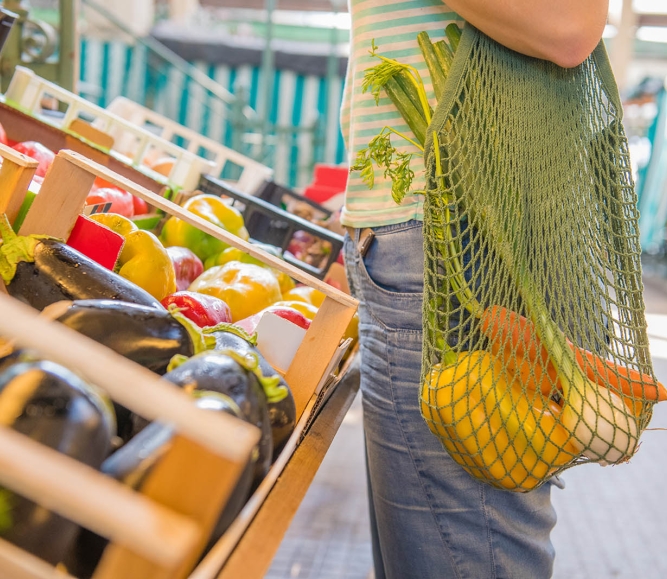Shutdown stresses counties, residents dependent on SNAP

Counties are scrambling to support their most vulnerable populations by working with food banks and community organizations to mitigate the impact of a disruption of Supplemental Nutrition Assistance Program (SNAP) and Special Supplemental Nutrition Program for Women, Infants and Children (WIC) benefits in November, due to the government shutdown.
Across the country, nearly 42 million people receive food assistance through SNAP and nearly 7 million pregnant and postpartum women, infants and young children receive WIC benefits, which include food assistance, lactation support, nutrition education, screenings and referrals. Without any additional action, SNAP recipients will not receive November benefits starting Nov. 1, and WIC participants could start to see disruptions in early November.
The U.S. Department of Agriculture (USDA) has nearly $6 billion in SNAP contingency funds, but the USDA has said it won’t utilize the funding. In mid-October, the White House reallocated $300 million from USDA’s Child Nutrition Account to maintain WIC benefits throughout the month, but those dollars are waning.
‘Getting people fed’
“Our job locally is, first of all, nobody’s coming to save us, we’re not waiting on anybody,” said Lucas County, Ohio Commissioner Pete Gerken. “… We have one singleness of purpose right now — getting people fed between now and the end of November.”
More than two dozen states have sued the Trump administration over its refusal to utilize the SNAP contingency fund for benefits during the government shutdown and the National WIC Association submitted a letter, signed by 44 national organizations, including NACo, urging the White House to provide an additional $300 million in emergency funds for WIC, which would sustain program operations well into November.
“This isn’t a red or blue issue, this is a refrigerator issue,” said Peaches Calhoun, a Franklin County, Ohio mother of four who relies on SNAP benefits to keep her family fed. She shared the essential nature of the funding at a news conference on Oct. 23 at the Ohio Statehouse.
“Every month, I watch that SNAP app like it’s the lottery,” Calhoun said. “The night before it reloads, I’m refreshing the screen, doing mental math, trying to make spaghetti stretch one more night.
“When I finally hit the store, I’m walking the aisles, aisle by aisle with my calculator out, switching strawberries for apples, cereal for oatmeal, and praying that that card doesn’t flash ‘insufficient.’ That’s not mismanagement — that’s motherhood under pressure.”
Larimer County, Colo. food bank
Forty-seven states have sent warnings to SNAP recipients regarding the looming lapse in November payments, but there’s been confusion about what that actually means for people receiving food assistance, according to Amy Pezzani, CEO of the Food Bank of Larimer County, Colo.
The food bank, which provides SNAP outreach and assists with enrollments, has received numerous calls from people who are unaware of the federal funding cliff, thinking that the warning is regarding their individual benefits and that they just need to provide more paperwork or re-enroll, she noted.
It’s local governments’ job to effectively communicate the gravity of the situation to their communities, because otherwise, many SNAP and WIC recipients won’t know about the lapse in funding until they go to the grocery store and realize that they can’t pay, according to Gerkin.
“People that live in poverty are living in what we call ‘the tyranny of the moment,’” Gerken said. “They don’t read the news … people will find this out gradually. EBT cards get filled up over time, so it’s not like everybody’s going to lose it Nov. 1. But word will start getting out quickly — that ‘My EBT card didn’t work.”
State Rep. Latyna Humphrey (D-Columbus) is sponsoring HB 502, legislation that would allow Ohio to use its Budget Stabilization Fund (also known as the state’s rainy day fund) to backfill any federal funding lapses in SNAP, WIC, and Temporary Aid to Needy Families (TANF). As of Oct. 29, the bill has been referred to the Ohio House Agriculture Committee, but has not been scheduled for its first hearing.
In Lucas County, almost 72,000 people — roughly 17% of the total population — received SNAP benefits in September, about 44% of whom are children. Gerkin said he has “no hope” that the Ohio legislature will act to help SNAP recipients, and that the county is mobilizing to support people at the community level, by joining forces with food banks, fundraisers, health departments and the city to address the service gap.
‘We have grit’
“The people who could fix this won’t and the people that need to fix it, like us, don’t have all the resources to do it,” Gerken said. “But I’ll tell you what we have — like every other county — we have grit and we’re determined in this, and we are not going to let our people go harmed.
“Now, how do you harness that energy into a system that gets things to people and where they need it? That’s a daunting challenge, especially to do in a week or two.”
Lucas County staff are meeting with SNAP recipients to learn more about their biggest concerns surrounding funding and how local government can directly support them, he said.
“We want our community to know we’re with them, they’re part of our response, and we’re ready to help ourselves when no one else will help,” Gerkin said. “And that’s just good local government — you have to figure out how to do for you what nobody else is.”
The Mid-Ohio Food Collective, the largest food bank in the state, serves 5,000 people a day, and that need could increase to 322,000 starting Nov. 1, according to Mike Cochran, the food bank’s senior vice president of communications and public affairs. Calhoun said she recently went to a local food pantry and helped stock the shelves at 9 a.m. By noon, there was no food left.
“And the line [for the food pantry] was still wrapped around the block, like a concert for survival,” Calhoun said. “You can’t tell people to just go to the pantry when the pantry is already out of bread.”
Between July and September this year, an average of 150 new families signed up for service each month through the Food Bank of Larimer County, according to Pezzani. Two weeks ago — in one week alone — the food bank had 179 new families sign up, she noted.
“This month, we have had already just shy of 500 [families sign up]” Pezzani said, on Oct. 28. “We probably will surpass 500 today, and we’re not even at the end of the month.”
Food banks usually rely on donations, but with significant increased need and a rapidly approaching lapse in food assistance, they’re having to purchase food, which is more expensive and takes time, Pezzani said. More than any kind of canned good, it’s cash that food banks need right now, she noted.
“There’s no way for the charitable food system to make up this loss … we cannot ‘food drive’ our way out of this,” Pezzani said. The need “really is money for us to access food at a much higher level — by the truckload, versus by the barrel-full.”
‘We’ve never dealt with something like this’
Of the 4,300 people in Larimer County who receive WIC benefits, 55% of them are children, aged 1 to 5, who are not eligible for the school system’s free breakfast and lunch program, but rely on WIC and the food bank to stay fed, according to Tom Gonzalez, Larimer County Department of Health and Environment’s public health director.
Roughly 40% of all infants in the country receive formula through the WIC program, and without that assistance, many children are at-risk of not receiving critical nutrients, which can lead to growth development issues and even death.
Most parents in the U.S. spend between $70 and $200 each month on formula, with the average falling around $100-$150 for standard formulas. The cost can rack up to “a car payment worth of groceries every two weeks for a mom trying to keep her baby fed,” Calhoun noted.
In Larimer County, 20% of infants enrolled in WIC are dependent on formula or breastmilk support, and many infants need prescription formula, which is specialized and more costly, according to Kori Wilford, Larimer County Department of Health and Environment’s office of communications and technology manager.
“We’ve never dealt with something like this,” Gonzalez said. “And to have families that will not be able to access formula is keeping many of us up at night.”
In Riverside County, Calif., WIC clients bring in between $5.5 million and $7.3 million to the local economy each month, and SNAP recipients contribute even more, according to Kimberly Saruwatari, the county’s public health director. The National Grocers Association has reported that a complete lapse in November benefits for WIC and SNAP would see billions of dollars in lost revenue across the industry.
“When SNAP stops, that ripple doesn’t end in [my] kitchen,” Calhoun said. “It hits every checkout line in Ohio. Grocery stores rely on food stamp shoppers to keep their doors open. When those customers disappear, stores lose profit. When stores lose profit, the farmers lose contracts, and when farmers can’t sell, the whole system collapses. It’s a domino line of disaster, and we’re all standing in front of it, pretending we don’t hear the rumble.”
Related News
Stretching small opioid settlement allocations helps funding do more
States and localities are set to receive $56 billion in opioid settlement dollars over an 18-year period, but not every county that receives settlement funding will get enough to build out infrastructure.
County News
USDA finalizes rule expanding SNAP work requirements



